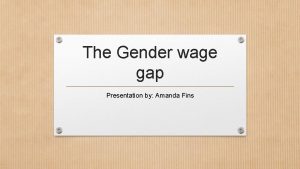New Workplace Practices and the Gender Wage Gap




















- Slides: 20

New Workplace Practices and the Gender Wage Gap. Can the New Economy be the Great Equalizer? Nabanita Datta Gupta 1, 2, 3 and Tor Eriksson 1, 3 1. Aarhus School of Business, 2. Danish National Institute for Social Research, 3. Center for Corporate Performance

A general remark o o o Linked e-e data are not only valuable because one can learn many new things from them Also the value of other data sources, e. g. questionnaires, can be increased if combined with linked e-e data. Especially surveys on policies, practices Can improve quality of questionnaire and response rate

Gender Wage Gap in Denmark o o DK has one of the lowest gender wage gaps, but stagnated since 1980’s Raw wage gap approx. 12%, much higher in private sector, higher for fulltime workers Private sector gender wage gap largely unexplained, even after controlling for HK Growing interest in firm-level factors: size, workplace organisation etc.

New Workplace Practices o o o Reorganization of work & adoption of NWP Widely diffused in U. S. (by 1997, 71% of firms had adopted some form of new HRM practices, Osterman, 1994, 2000), less so in Europe, but more frequently in Scandinavia Research on effect of NWP on costs & productivity; less on impact on workers’ wages (establishment-level)

Effect of NWP on Gender wage gap Decrease o Breakdown of occupational lines o Decentralization of supervisory authority o Incentive-based pay systems o Increased flexibility of work-schedules o Gender differences in multitasking etc. Increase o Family responsibilities mean lower labour force attachment o Short workplace tenures o Decentralization removes wage floors o Increased wages to (mostly male) supervisors (facilitators) following adoption

Data o o o 1999 survey on work and compensation practices merged to a matched employer-employee database 224, 262 workers in 1, 387 firms in the private sector in Denmark. This paper focuses on manufacturing; on average 194, 838 employees per year in 691 firms Share of females in blue collar jobs is lower than for men, but not very much (60 and 66 %, respectively) Whether or not firm has implemented one of the following: self-managed teams, job rotation, quality circles, TQM, benchmarking, project organisation When each work practice was adopted

New Workplace practices o o o Self-managed teams Job rotation Quality circles Total quality management (ISO 9000) Benchmarking Project organisation

Empirical Model o o o Log hourly wages in group i, firm j, time t Thus, gender gap in wages Or,

Methodological Issues o o o Firm heterogeneity ”Best practices” or necessity; need to measure performance before practices are adopted Serial correlation (Bertrand et al. , 2004) Worker sorting -more able workers self-select into firms that offer NWP. Lack instruments Measurement of NWP — implementation vs. value? Jointly, individually, clusters (synergies). Should interactions be allowed? Specified a priori or data-defined?

Descriptives


Impact of adoption of at least one NWP on wages

Impact of number of NWP on wages

Impact of all NWP on wages

Impact of separate NWP on gender wage gap (salaried employees)

Impact of separate NWP on gender wage gap (manual employees)

Interpretation of results (1) o o o Rent sharing If females strongly prefer the new, less hierarchical organisations, consistent with compensating wage differentials Differential sorting. Lack of counterfactual prevents us from DID on newcomers and incumbents. Wage growth equations instead. No difference in post-NWP wage growth between newcomers/incumbents.

Interpretation of results (2) o o Real differences in productivity. Women can’t exploit gains from NWPs because of family responsibilities. No difference in gap for women with/without (small) children The facilitator hypothesis (Black and Lynch, 2004): male supervisors are rewarded for supporting and implementing the NWPs. Little support. Proportion of males in the middle management positions is roughly the same in firm with and without new work practices. Gender gap for salaried workers is not larger in firms that have adopted the new practices

Conclusions o o o Most widely implemented practices: self-managed teams, project organisation and job rotation schemes DID model of wages and work practices shows that n (1) the gains from introduction of new practices accrue to salaried males, n (2) wage losses accrue to females, and thus n (3) gender gap in pay widens at the level of the firm. Individual practices; for hourly paid workers, teamwork and benchmarking widens the gap, whereas quality circles reduces it. For salaried employees gap mostly unchanged, save project organisation for which it is reduced.

Conclusions (contd. ) o o o Correction for serial correlation moves the results only little Unable to determine whether positive effects on male wages a result of sorting or represent real rents New practices/new economy is not the great equalizer; in most cases benefit men and not women
 Wage and workplace standards ct
Wage and workplace standards ct Strategic gender needs and practical gender needs
Strategic gender needs and practical gender needs Slidetodoc.com
Slidetodoc.com Gender pay gap lösungsansätze
Gender pay gap lösungsansätze Contoh gender analysis pathway (gap)
Contoh gender analysis pathway (gap) Qo'shma gap haqida ma'lumot
Qo'shma gap haqida ma'lumot Language processor mcq
Language processor mcq What are the objectives of wages and salary administration
What are the objectives of wages and salary administration Principles of wage and salary administration
Principles of wage and salary administration Wage and salary administration
Wage and salary administration Hattrick wage calculator
Hattrick wage calculator What is a wage
What is a wage What is time rate wage system
What is time rate wage system Nominal gdp
Nominal gdp Mdot prevailing wage
Mdot prevailing wage Croatia minimum wage
Croatia minimum wage Minimum wage argument
Minimum wage argument The minimum wages act 1948
The minimum wages act 1948 Average wage in romania
Average wage in romania Nominal gdp
Nominal gdp The minimum wages act 1948
The minimum wages act 1948






































